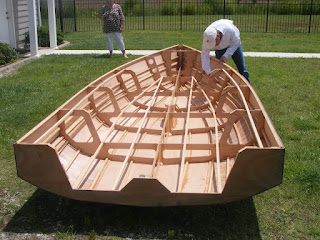Boat Building Blueprints: Decoding the Technical Drawings
Building a boat from scratch is a challenging yet incredibly rewarding endeavor. The foundation of any successful build lies in understanding the boat building blueprints. These aren't simple diagrams; they're complex technical documents that meticulously detail every aspect of the vessel's construction. This article will equip you with the knowledge to confidently navigate these blueprints, turning a daunting pile of paper into a tangible reality.
Understanding Blueprint Terminology
Before diving into the specifics of your chosen design, familiarize yourself with common terms and symbols. Blueprint languages vary slightly depending on the designer, but core elements remain consistent. You'll frequently encounter terms like stations (cross-sections of the hull), buttocks (longitudinal curves), waterlines (horizontal lines showing the hull at various water levels), and frames (the skeletal structure of the boat). Understanding these terms forms the basis of your interpretation. Many blueprints use specific abbreviations or notations – consult the blueprint's legend or key for clarification. Don't hesitate to research common boat building terminology online if you encounter unfamiliar terms.
Deciphering Scales and Dimensions
Pay close attention to the scale indicated on the blueprint. This ratio dictates the relationship between the drawing and the actual boat dimensions. Accurate measurements are critical; a slight miscalculation can significantly impact the boat's structural integrity and seaworthiness. Use a precise measuring tool, preferably a scaled ruler, and double-check all measurements. Many blueprints also include detailed dimension tables for quick reference. Verify the units used (inches, centimeters, etc.) to avoid costly mistakes.
Interpreting Key Blueprint Sections
Boat building blueprints are typically divided into several key sections. Each provides essential information about a specific aspect of the boat's construction. Mastering the interpretation of these sections is paramount for successful construction. Carefully study each section, noting the details provided, and compare them to the overall design plan.
Hull Design and Construction
This section forms the heart of the blueprint. It provides detailed information about the shape and construction of the hull, including:
- Body plan: A series of cross-sections (stations) showing the hull's shape.
- Sheer plan: A top view showing the boat's overall profile and deck lines.
- Half-breadth plan: A side view showing the hull's width at various points.
- Construction details: Specifications on the type and thickness of materials, including plywood, fiberglass, or other components.
Careful study of these elements is crucial to accurately replicate the hull's shape and ensure structural integrity.
Deck and Superstructure
This section details the construction of the boat's deck and any superstructure, such as a cabin or cockpit. It includes plans for:
- Deck layout: Showing the placement of hatches, handrails, and other deck fittings.
- Superstructure plans: Detailed drawings for cabin sides, roofs, and other structural elements.
- Framing details: Specifications for the support structure of the deck and superstructure.
Understanding these details is essential for creating a safe and functional upper structure.
Beyond the Drawings: Material Selection and Construction Techniques
While blueprints provide the framework, they don't always specify the exact materials or construction techniques. This information often comes from accompanying text, online resources, or the builder's own experience. Choosing appropriate materials is vital; strength, durability, and water resistance are key considerations. Consider researching different methods of construction (e.g., stitch-and-glue, strip-planking, cold-molded) to determine which best suits your skills and the design's requirements. Remember that successful boat building is a combination of careful planning, precise execution, and a thorough understanding of the blueprints and construction techniques.



